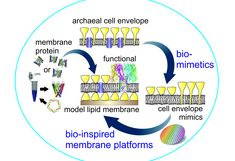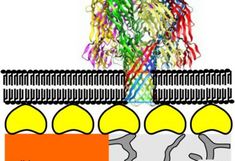Designing and utilization of biomimetic membrane systems generated by bottom-up and self-assembly processes is a rapidly growing scientific and engineering field. Elucidation of the supramolecular construction principle of archaeal cell envelopes which are frequently composed of a cytoplasma membrane with an S-layer lattice anchored by a transmembrane domain led to new strategies for generating stable functional lipid membranes at meso- and macroscopic scale. S-layer proteins, lipids, and polysaccharides are the basic building blocks for the assembly of S-layer supported lipid membranes. These biomimetic membrane systems are distinguished by a nanopatterned fluidity, enhanced stability and longevity and thus, provide a dedicated reconstitution platform for membrane-active peptides and transmembrane proteins. Basic research elucidates natural functions of cell envelope structures in more detail. Moreover, novel biomimetic architectures will be designed by combining natural and modified building blocks. Exciting areas for application of composite S-layer membrane architectures concern membrane platforms for studying membrane-active peptides and transmembrane proteins over pharmaceutical screening devices to sensor systems involving specific membrane functions. Contact person: Ao.Univ.Prof. Dr. Bernhard Schuster


